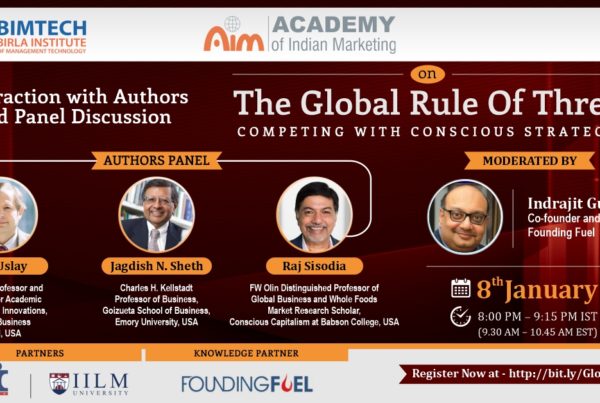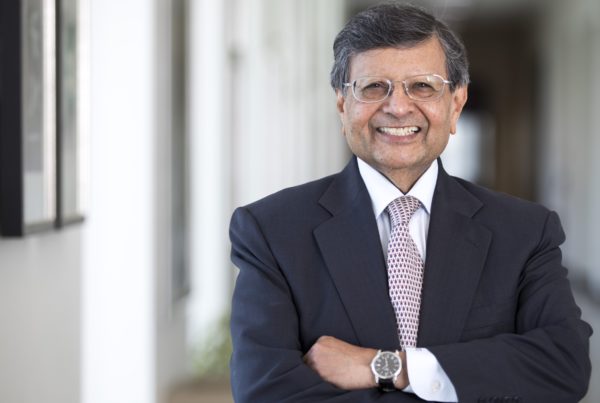Published: Feb 14, 2008 in Knowledge@Emory
When Jagdish Sheth senses the subtle beginnings of a shift in business, he submerges himself in a topic until all of his questions have been answered. This corporate strategist, chaired professor of marketing at Emory University’s Goizueta Business School, and founder of the India, China and America Institute’s (ICA) latest fascination has resulted in a new book, Chindia Rising: How China and India Will Benefit Your Business (Tata McGraw Hill India, 2008), and a recent lecture on “The Rise of Chindia (China and India) and its Global Impact. The event was held at Goizueta and sponsored by the Claus M. Halle Institute for Global Learning, which brings together heads of state, distinguished policymakers, and influential intellectuals from around the world to dialogue with the Emory and Atlanta communities on issues of global importance.
During the lecture, Sheth gave a historical perspective to the shifting power structure and shared his predictions on the impact of this change on culture and global business.
“In the 1800s the Europeans had the global economic power, the 1900s was the American century and the Asian nations will head the 21st century,” says Sheth. “In a world where market power reigns supreme, it will be the economies of the reigning superpower, the U.S., and the emerging superpowers—India and China—that will have the greatest impact on our globalizing world.”
According to Sheth, forces driving this shift include the collapse of Communism, economic pragmatism, the aging of affluent nations and globalization. “If the second half of the 20th century was permeated by the ideological struggles, such as Communism versus Capitalism, then it is my strong belief that markets and economic interests will be the overarching drivers of the first half of the 21st century,” he says.
While the shift in economic power will bring conflicts and confrontations, the benefits will far outweigh any problems, Sheth says. Unlike the globalization of the 1800s when the British used a colonial system to establish a worldwide network of military and economic influence, the current globalization features a more even balance of power.
“The balance in power can be attributed to the aging, and in many cases, shrinking populations of the developed countries, which will not be able to sustain their wellbeing without the human resources and growth markets of the developing countries,” Sheth explains.
A new measure of world economies by the International Monetary Fund supports the prediction that China and India are growing economic powerhouses. In a measure of Purchasing Power Parity (PPP), the United States is ranked at the top with $13 trillion, but China is a close second with $9.9 trillion in purchasing power. Meanwhile, India is a not-too-distant fourth with a purchasing power of $4.2 trillion.
“China is the second largest economy based on the PPP index and just surpassed Japan. It will be the largest single economy by the year 2020,” Sheth says. “India is the fourth largest economy, and it will become the third largest economy by the year 2010.”
The old power triad—the United States, the European Union and Japan—controlled 75% of world trade, but now desperately needs economic growth to sustain employment and political stability, Sheth explains. The growing economy of the developing countries will create a new power triad—the U.S., China and India—which will have a tremendous impact on global growth. According to Sheth, that triad is already forming.
“As we look to the future, there are many concrete signs that a cooperative environment is already developing. Despite a long history of mistrust, China and India are beginning to forge strong economic ties,” Sheth explains. Trade between the two countries, which was less than $200 million five years ago, has grown to more than $30 billion and will likely be more than $50 billion in another 3 years, he says.
Furthermore, Indian companies are already investing in China, as well as locating manufacturing operations there, Sheth remarks. There are also indications that India is opening up to much greater Chinese investment, especially in infrastructure projects. “The optimism for this relationship is so great that one of the major economic advisors to the Indian government, Jairam Ramesh, wrote a book called Making Sense of Chindia, which examines the huge potential for trade and other forms of exchange that exist between the two countries,” he says.
The impact can already be felt with Chindia leading the growth of the largest consumer markets, including cell phones, steel and education. Also, the rise of Chindia’s global enterprises, such as Mittal Steel, Haier and China Mobil attest to its growing economic prowess, Sheth says. And research and development are shifting to Chindia. “China will surpass Japan in research and development,” he adds.
Similarly, mutual cooperation has begun between the U.S. and India, Sheth points out. U.S. corporations have outsourced a major amount of call-center operations and IT development to India, and are now at the beginning of a wave of investment in research and development facilities in the country.
In a major breakthrough that portends a much greater level of cooperation, the two countries reached an agreement in March 2006 on a sweeping agenda for economic and scientific cooperation, set a three-year target to double their trade and reached an understanding on implementation of a July 1995 civil nuclear co-operation agreement that will allow the U.S. government and private companies to supply nuclear technologies and fuel to India, Sheth explains.
The emergence of Chindia’s consumer-driven economy and the rise of its global enterprises will be a key driver of innovation, impacting affordability and accessibility of products, technologies and services, Sheth says.
That cooperation has not extended to the U.S. and China. This is despite the fact that U.S. companies have been major investors in China’s growth, and that a tremendous amount of inexpensive goods from China have flowed mostly unimpeded into the U.S.
“Also, China is one of the largest holders of U.S. government bonds, but there is still a high level of economic, diplomatic and military mistrust and fear between the countries,” Sheth explains. “My hope and expectation is that India, China and the U.S. will set aside their remaining past differences to expand their economic and geopolitical cooperative efforts. This is something that should be encouraged by policy research institutes, NGOs, businesses, industries and citizens, both inside and outside of the three countries.”
According to Sheth, the stakes are high. “If successful, the United States will have provided an opportunity for historic cooperation to alleviate poverty and subsistence economy in the world, just as we cooperated to eradicate polio and small pox,” he says.
Sheth predicts the new power triad will also result in China and India emerging as world leaders in politics. “They will be integrated into world political, social and economic forums and institutions,” he predicts. “The rise of Chindia will redefine capitalism and democracy.”




